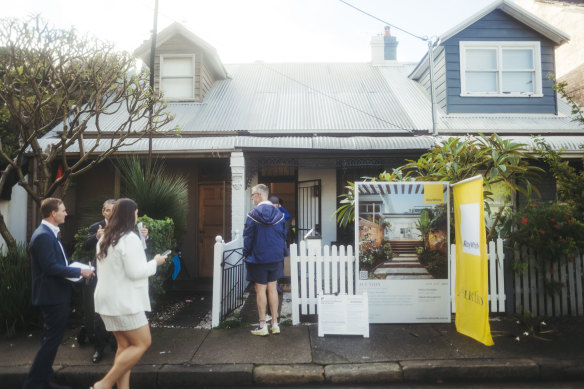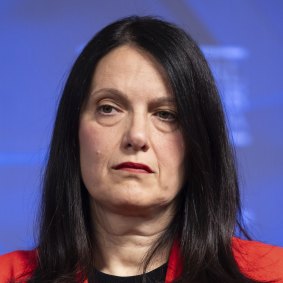‘Parents are kicking in $200,000 or $1 million’: Home deposit gap widens
Home buying hopefuls have to save tens of thousands of dollars more for a deposit compared to only five years ago.
But buyers under pressure from rising prices would also have to find more cash every month to cope with higher mortgage repayments.

A listed property in the Sydney suburb of Newtown. Since June 2019, the amount needed for a an average deposit in Sydney has increased by more than $100,000.Credit: Dion Georgopoulos
In June 2019, a buyer hoping to purchase the median house in Sydney with a 20 per cent deposit would have needed to find $207,000, plus stamp duty and transaction costs, Domain data for the June quarter shows.
But five years on, that hurdle has jumped to more than $332,000.
In Melbourne, someone hoping to buy a typical house five years ago would have needed a 20 per cent deposit of $165,000, but now would need more than $213,000, according to the Domain data.
Brisbane buyers would have needed a deposit of about $113,000 in June 2019, but that figure now stands at $195,000.
And Perth buyers who could have bought a house with savings of $106,000 plus costs would now need to find $170,000.
Prices are higher even though interest rates have also risen, which has reduced the amount of money home buyers can borrow.
AMP senior economist Diana Mousina said it now took a dual-income couple close to 10 years to save a 20 per cent deposit, whereas it took about three to four years, three to four decades ago.
“It is a challenging environment for buyers trying to get into the market,” Mousina said.
“Sydney and Melbourne are still quite expensive … There are definitely pockets where things aren’t as expensive but across the nation you’d have to say housing affordability is still a massive challenge.”
She said people want to live in expensive cities such as Sydney, Melbourne and Brisbane because that was where many jobs are located.
Mousina attributed the price rises to an imbalance between supply and demand.
“We fundamentally have an undersupply issue in Australia, where over the past 15 years we haven’t been building enough homes,” she said.
“So housing demand has been running above supply nationally.”
Not enough homes have been built to accommodate the new arrivals since Australian borders reopened after COVID lockdowns, Mousina said.
She said home prices could push even higher, albeit not at the same pace, over the next year or two, unless there were further interest rate rises, which would reduce demand.
The rise in prices leaves buyers constrained to purchasing a smaller home than they would prefer, leaving the major cities and moving to a regional area, or renting for longer, perhaps while buying an investment property.
Mousina said some buyers were managing to get into the market by using the bank of mum and dad as a source of their deposit or a guarantor for their property.
MortgageWorks director Anthony Roddy said state and federal government assistance was helping first home buyers avoid stamp duty or purchase costs on a low deposit. But the schemes are capped, which means they do not stretch as far in Sydney as elsewhere.
Some parents are acting as guarantors so their offspring can avoid paying lender’s mortgage insurance. Other families are making cash gifts to help with the deposit.
“We often see some form of parental gift,” Roddy said. “It’s a little bit less common to see a really big one, it’s a little bit less common to see someone buying a $2 million property and they’re only borrowing $800,000,” he added, although he “might see a couple of those a year”.
“Parents are kicking in $200,000 or $1 million, whatever it may be, for a deposit. But I think what we’re seeing in the last couple of years is parents are helping with the servicing of loans.”
Roddy said as an example, some banks would not count private school fees as household expenses when calculating how much someone could borrow, because the banks realised that in many cases, grandparents are paying the school fees.

Independent economist Besa Deda.Credit: Alex Ellinghausen
Other borrowers pay lender’s mortgage insurance if they cannot save a 20 per cent deposit, he said.
Independent economist Besa Deda said housing affordability had become quite stretched after prices increased since the start of COVID, and interest rates rose more recently.
“Some potential borrowers are looking further away, so they might be looking to more affordable markets, so they might be looking to areas further away from the CBD or further away from the coastline,” Deda said.
“[They’re choosing] dwellings with more confined spaces – apartments are generally more affordable than standalone dwellings.”
She noted the lacklustre residential construction activity coincided with strong population growth.
“The challenge, and I think particularly for younger Australians, is they need a bigger deposit and it will also likely take them longer to pay off that loan,” Deda said. “Whereas older Australians [who] might have got into the market 10 or 20 or 30 years ago, that dynamic wasn’t as prevalent.”